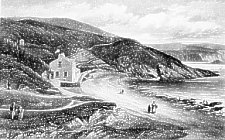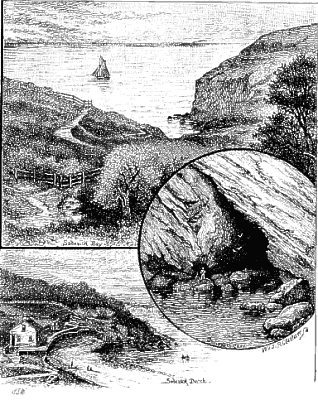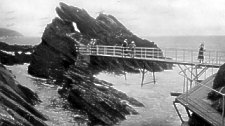
Port Soderick Hotel & bay from a Phillips' view c.1865

Port Soderick Hotel & bay from a Phillips'
view c.1865
One end of the Marine Drive Tramway which opened 1896 - developed by the Forrester Brothers, Morris and Thomas (confectioner and cook) at about the same time to provide a tourist 'trap' though it was catering for the tourist trade from at least the 1860s - Kerruish's guide of 1855 advertises 'The St Helena Hotel' at Port Soderic kept by Sergeant Joseph Ion, late of the St Helena regiment.
An artistic view of c.1880 was given in an 1883 publication (Barrow Route to I.O.M.):
 |
Port Soderick.-This delightful spot is about three miles from Douglas, and may be reached in a variety of ways. The intending visitor may proceed either by land or water, and if he prefers to be indebted only to his own exertions, he will find the walk one of the prettiest and most enjoyable about Douglas. Arriving, either by road or rail, he will find himself in a lovely glen which stretches down from near the railway station to the bright pebbly beach of the bay. This secluded glen alone would well repay a visit, with its charming woodland scenery and mountain rivulet running down to the sea. The rocky scenery of the bay is very grand, and in the cliffs on the south side are three caves, one being of very considerable extent. |
An 1895 photo (Beecham's Isle of Man vol 1) shows some development which can be compared with a 1900 view showing the considerable development by the Forrester Brothers.
An inclined railway, erected 1897 and opened 1898, links the beach with the Marine Drive Tramway. This railway was originally the 1887 Falcon Cliff lift 4' gauge with new cars. The railway was dismantled between 1947/9 with the cars surviving somewhat longer as henhouses.
The attractions continued around the headland supported on iron supports let into the rocks - now all remains of these are the paths and stubs of rusting iron. The two strange huts in the near foreground on the right hand view are the original cars from the Falcon-Cliff system. The original hotel can still be seen amidst the mass of new accretions.

Dragon Rock, Port Soderick
Numerous attractions existed to amuse the tourists - Dearden and Hassell include a postcard illustrating a milking session on the beach. The main attractions were the "smugglers' caves" (almost certainly not used as such ), oyster beds and glen (formed by the Crogga river). The hexagonal building, left foreground, is a camera obscura similar in principle to the Grand Union camera obscura on Douglas Head. Access was by road, railway and boat from Douglas as can be seen in the c. 1935 photograph below:
PORT SODERICK AND THE CROGGA GLEN.
This beautiful inlet of the Manx coast has long been a favourite resort with both residents and visitors. By railway or road it is about three miles from Douglas ; and by the Southern Electric Tramway, or the Marine Drive, it is a iittle over two miles. Port Soderick is the southern part of a shallow indentation of the land, extending from the Little Ness to Port Soderick Head. It is surrounded by high precipitous cliffs ; and at its landward side it opens into a lovely wooded glen, through which the Crogga Stream flows. Its southern headland is pierced by three interesting caves, known to every visitor to the Island as the Smugglers’ Caves; which, on account of their traditional use, and of their present appearance, are well worth examination. The first of the three is merely a crevice in the rock—a fault in the strata worn by the sea into its present form ; which the visitor may walk through at all states of the tide. The other two are farther from the beach, and can only be reached at low water, or by boat. One of them, the Smugglers’ Cave par excellence, is large and winding, and extends some hundreds of yards into the land. To explore it properly, candles are required, which can be obtained at the hotel, or from the men on the beach. The view from the cliffs is very fine, extending southward to Derbyhaven and Langness. The walk along the cliffs, over St. Anne’s Head, to Port Grenaugh, is very pleasant. There is a good hotel on the beach, as well as several refreshment houses, where dinners, teas, and other refreshments may be obtained at moderate rates.
The Crogga Glen is a fine example of a Manx coast glen. It is surrounded by rounded hills, from 400 to 600 feet in height ; and is richly wooded, especially in its upper parts, and along the course of the Crogga. The Railway Station is about half a mile from the beach, and a little higher up is Crogga House. The return to town may be made by the Old Castletown-road, a pleasant journey of nearly three miles, by the Marine Drive, or by the railway.
See also Mates Guide entry.
Post WW2 the Marine Drive Tramway closed and sold its property to the Manx Government, the tramway was converted to a roadway in 1956 (though closed to motorists because of safety fears in 1976), Port Soderick was bought by the Government in 1956 and refurbished, the glen and much of the land was kept when the hotel etc were sold into private hands in 1984 - currently (2017) extremely delapidated with plans to convert to an exclusive housing development.
There is also a Manx legend of a submerged Island at Port Soderick
S. Dearden and K. Hassell The Isle of Man A Postcard Tour
Volume 2 : Douglas and the East (ISBN 1-872074-76-6) Richard
Stenlake Publishing 1996
S. Basnett & K. Pearson Double Century:the story of two unique Manx
Tramways Chetwode:Adam Gordon (ISBN 1-874422-17-6) 1996
|
|
||
|
Any comments, errors or omissions
gratefully received The
Editor |
||